Related Research Articles
Tanka is a genre of classical Japanese poetry and one of the major genres of Japanese literature.

Torahiko Terada was a Japanese physicist and author who was born in Tokyo. He was a professor at Tokyo Imperial University, a researcher at RIKEN, and worked on a wide range of topics in physics. He was also a professor at the Earthquake Research Institute.
Hiraide Shū was a novelist, poet, and lawyer in late Meiji period Japan. As a lawyer, he was noted for his involvement in the defense of the accused in the High Treason Incident.

Hakushū Kitahara is the pen-name of Kitahara Ryūkichi, a Japanese tanka poet active during the Taishō and Shōwa periods of Japan. He is regarded as one of the most popular and important poets in modern Japanese literature.

Lieutenant-General Mori Rintarō, known by his pen name Mori Ōgai, was a Japanese Army Surgeon general officer, translator, novelist, poet and father of famed author Mari Mori. He obtained his medical license at a very young age and introduced translated German language literary works to the Japanese public. Mori Ōgai also was considered the first to successfully express the art of western poetry in Japanese. He wrote many works and created many writing styles. The Wild Geese (1911–1913) is considered his major work. After his death, he was considered one of the leading writers who modernized Japanese literature.

Takuboku Ishikawa was a Japanese poet. Well known as both a tanka and "modern-style" or "free-style" poet, he began as a member of the Myōjō group of naturalist poets but later joined the "socialistic" group of Japanese poets and renounced naturalism. He died of tuberculosis.
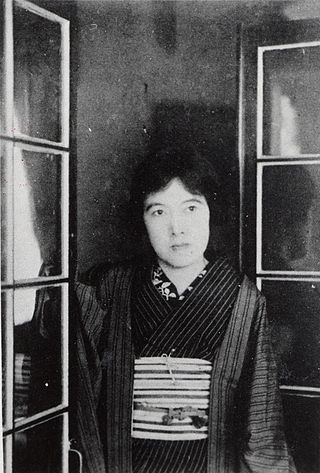
Yosano Akiko was the pen-name of a Japanese author, poet, pioneering feminist, pacifist, and social reformer, active in the late Meiji era as well as the Taishō and early Shōwa eras of Japan. Her name at birth was Shō Hō. She is one of the most noted, and most controversial, post-classical female poets of Japan.
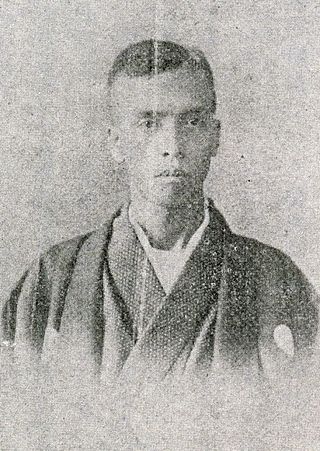
Saitō Masaru, better known by his pen name Saitō Ryokuu, was a Japanese author and critic who lived during the Meiji Era. His Dharma name was Shungyōin Ryokuu Suikaku Koji (春暁院緑雨醒客居士), which was chosen by Kōda Rohan.
Iwanami Shoten, Publishers is a Japanese publishing company based in Tokyo.
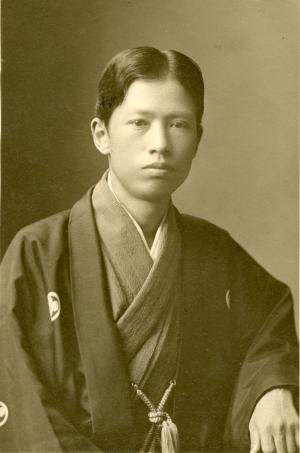
Hishida Shunsō was the pseudonym of a Japanese painter from the Meiji period. One of Okakura Tenshin's pupils along with Yokoyama Taikan and Shimomura Kanzan, he played a role in the Meiji era innovation of Nihonga. His real name was Hishida Miyoji. He was also known for his numerous paintings of cats.
Nationality words link to articles with information on the nation's poetry or literature.
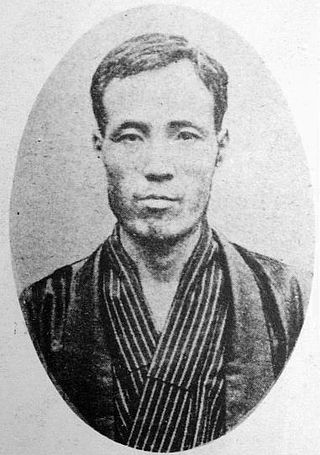
Tekkan Yosano was the pen-name of Yosano Hiroshi, a Japanese author and poet active in late Meiji, Taishō, and early Shōwa period Japan. His wife was fellow author Yosano Akiko. Cabinet minister and politician Kaoru Yosano is his grandson.

Georges Ferdinand Bigot was a French cartoonist, illustrator and artist. Although almost unknown in his native country, Bigot is famous in Japan for his satirical cartoons, which depict life in Meiji period Japan.

Morita Yonematsu, known under pen name Morita Sōhei, was a novelist and translator of Western literature active during the late Meiji, Taishō and early Shōwa periods of Japan.

Kaoru Yosano was a Japanese politician. He was a member of the Liberal Democratic Party (LDP), the Sunrise Party of Japan and former member of the House of Representatives, serving his ninth term in the Lower House representing Tokyo's first electoral district until his defeat in the 2009 Japanese general election. He was Chief Cabinet Secretary to Prime Minister Shinzō Abe from August 2007 to September 2007, and Minister of Economic and Fiscal Policy in Tarō Asō's administration from February to September 2009.

Sakutarō Hagiwara was a Japanese writer of free verse, active in the Taishō and early Shōwa periods of Japan. He liberated Japanese free verse from the grip of traditional rules, and he is considered the "father of modern colloquial poetry in Japan". He published many volumes of essays, literary and cultural criticism, and aphorisms over his long career. His unique style of verse expressed his doubts about existence, and his fears, ennui, and anger through the use of dark images and unambiguous wording.
Otemoyan is a Japanese folk song (min'yo) from Kumamoto Prefecture. It is played by mass performers dancing in the streets of Kumamoto in the summer. It is usually accompanied by shamisen, taiko drums and other percussion, and the Japanese used has a southern Kumamoto accent.
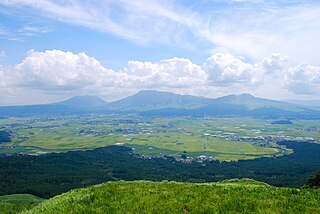
The history of Kumamoto Prefecture has been documented from paleolithic times to the present. Kumamoto Prefecture is the eastern half of Hinokuni, and corresponds to what was once called Higo Province. Exceptions are the parts of Kuma District, which had once been part of Sagara Domain, and Nagashima which was included in Kagoshima Prefecture.

Subaru (スバル) was a literary magazine published monthly in Japan between January 1909 and December 1913. The name of the publisher was Subaru (昴), written in kanji as opposed to the magazine title written in katakana.
Utsubo Kubota was a Japanese tanka poet. He also wrote poetry in other forms, as well as prose fiction and non-fiction critical and scholarly works on Japanese classical literature. He was a lecturer at Waseda University.
References
- Five Pairs of Shoes. Yosano, Tekkan, et al. in Meiji Bungaku Zenshuu, 94, Chikuma Shobou, 1974.
- Five Pairs of Shoes, Noda, Utaro, Nihon Kyoudo Bungei Sousho Kankoukai. 1978.
- Five Pairs of Shoes, Goninzure, Iwanami Bunko, Tokyo, 2007.
- Five Pairs of Shoes and Kumamoto, Amakusa Hamana, S. 1983.